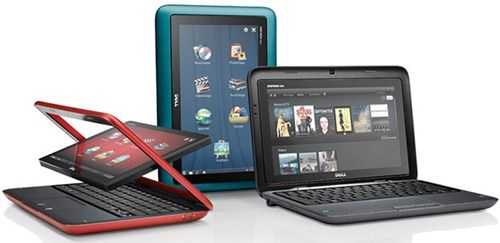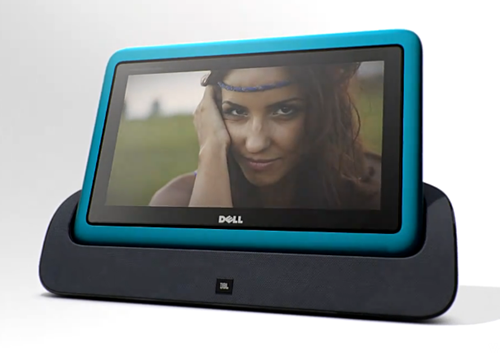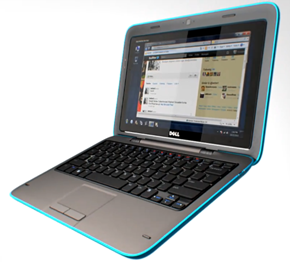 According to Brooke Crothers from Cnet who cites “industry sources familiar with the launch plans inch, the Dell Duo [tracking page] could launch on November 23rd.
According to Brooke Crothers from Cnet who cites “industry sources familiar with the launch plans inch, the Dell Duo [tracking page] could launch on November 23rd.
I’m torn between loving and hating the Dell Duo.
For one, I think they have a very interesting take on the convertible form-factor. It’s novel and will definitely get the attention it’s looking for from consumers. I can see people looking at it next to a typical (boring) netbook and opting for the Duo because of its neat design (given that they are similarly priced). The issue is that when the screen is flipped to put the device into slate mode, the user loses access to the trackpad and keyboard.
 On the other hand, I’ve long exclaimed my hatred for touchscreen “shells inch that sit on top of Windows. We’ve been using and testing UMPCs for years and this is definitely nothing new. After lots of testing, what have we found? The best UMPCs were those that don’t compromise on controls and then try to make up for it with a poorly designed touchscreen shell. The best ones have usable keyboards and mice intact, and allow users to interact with Windows the way that it was designed to be interacted with using a keyboard and mouse.
On the other hand, I’ve long exclaimed my hatred for touchscreen “shells inch that sit on top of Windows. We’ve been using and testing UMPCs for years and this is definitely nothing new. After lots of testing, what have we found? The best UMPCs were those that don’t compromise on controls and then try to make up for it with a poorly designed touchscreen shell. The best ones have usable keyboards and mice intact, and allow users to interact with Windows the way that it was designed to be interacted with using a keyboard and mouse.
Trying to drop a shell on top of Windows 7 and then claiming it a “touchscreen computer inch doesn’t make it useful. Users need to do more than play a slideshow, play a track from their music library, or use some proprietary touchscreen app. They need to be able to control the applications that they use on a daily basis, in an efficient way.
All of this begs the question: will people actually use the touchscreen mode on the Dell Duo? Or will it quickly fade from a neat idea to a rarely used feature?
I have a convertible HP Tablet. I love it and use it as my full time computer. The only time that I utilize the touchscreen is when it’s in slate mode and when I’m using it for digital ink input. I’ve actually disabled the finger touch input because it interferes with the handwriting, and it rarely, if ever, offers any benefit over a mouse and keyboard (remember, we’re talking Windows here).
The issue with the Dell Duo is that it lacks digital ink input (or I should say good digital ink input) because it uses a capacitive touchscreen which is incapable of tracking a pen unless it’s contacting the screen.. For me, this would make the Duo relatively useless in convertible its slate mode.
 But different people use computers in different ways. Will users find useful ways to use the Duo in it’s keyboardless and mouseless slate mode? Let’s hear from the readers, how would you use it?
But different people use computers in different ways. Will users find useful ways to use the Duo in it’s keyboardless and mouseless slate mode? Let’s hear from the readers, how would you use it?











The Ever Interesting Dell Duo Could Launch Next Week, Will the Slate Mode be Useful? http://www.umpcportal.com/?p=22737
The Ever Interesting Dell Duo Could Launch Next Week, Will the Slate Mode be Useful?: Duo press photo" src="http… http://bit.ly/aljsJW
#technology The Ever Interesting Dell Duo Could Launch Next Week, Will the Slate Mode be Useful?: Duo press phot… http://bit.ly/9K17Fq
RT @umpcportal: The Ever Interesting Dell Duo Could Launch Next Week, Will the Slate Mode be Useful? http://www.umpcportal.com/?p=22737
The Ever Interesting Dell Duo Could Launch Next Week, Will the Slate Mode be Useful?: Duo… http://goo.gl/fb/oDMUk
The Ever Interesting Dell Duo Could Launch Next Week, Will the Slate Mode be Useful? (Liliputing) http://is.gd/hedAU #tablet #netbook #dell
I’m not a trackpad user or a touch typist so me and my BT mouse might like it although I still have my eye on the HP tm2t with Core i5 and discrete graphics.
We shall see.
Assuming decent pricing its an interesting device. Fanless, judging from the images, capable hardware (though the lacking capabilities as desktop replacement if the geaphics chip of current Atoms really can’t even do 1680×1050, a common monitor resolution currently) and a lot of flexibility.
For me this device would be great, if the compromises are acceptable. What I’d need pen input for is just doing sketches. A capacitive screen with a capacitive-capable pen should suffice for that. And pen input is indeed where Windows has good software (Windows Journal, Annotating features of pdf viewers (which are lacking in open source environments as of now)…). Also, while windows isn’t designed for touch input, you can easily tweak it (dpi settings probably) to work at least reasonably well for limited usage scenarios like couch surfing.
However, I can’t judge the quality of capacitive stylus technologies – is there any that provides pin point exactness to the point of targeting single pixels? Something with an actual tip…
If no such stylus is available, well… Then the device is indeed useless to me.
Any opinions of this with the touch friendly (or at leasts thats what i read) ubuntu 10.1
I agree with Windows 7 being useless in slate mode. Why not get an iPad for browsing/apps and keeping your current laptop?
I did that. Couldnt be happier.
Well, what would have been, if you had needed at that time some additional smaller productive device with good compatibility (available software and fileformats) with your main productive device?
Though indeed, the dell duo has some problems of justification compared to a windows tablet plus keyboard-case, depending on price and availability compared to such. I’m hoping a lot for that scenario.
The Ever Interesting Dell Duo Could Launch Next Week, Will the Slate Mode be Useful? http://bit.ly/cWzKE1
You mentioned that the HP Tablet can be written on with a pen type device. This is exactly what I want but all the devices I’ve found are completely useless for this as they detect your hand leaning on the screen too. Does the HP slate not have a “Capacitive” touch screen? if not, what type of screen does it have? and are there more devices like this?
Traditional tablets detect the proximity of the stylus by using an electrostatic field. When the stylus comes within about an inch of the screen, touch is turned off, giving 100% reliable palm rejection.
@Rob… I currently have the HP Touchsmart tm2 and works great. It has multi-touch and does have capacitive screen and also a digitizer that works great with the pen, so no vectoring while inking on the tablet. I also use my iPad 3G for when I just need it and can get work done easily.
@HG… So is it normal for capacitive screen devices to support “digitizing” or “Inking”? Does this mean that they have a mode in which they ignore touches from your skin and only respond to a pen-type device? Also, please forgive me for my ignorance, but I don’t know what vectoring is.
@ Rob: Basically all touchscreen devices support inking in theorie – however, the only technology I currently know where only the pen is recognized is that used by wacom – I think its based on inductive coupling between the pen and coils somewhere around or behind the screen. Well, there are some radio based technologies too I think, but they usually require the pen to have a power cell, so they are probably significantly less convenient.
The reason is simple – for a touchscreen there is no difference between the pressure/capacitance/WhateverIsUsedByTheTechnology of a pen’s tipp and whatever part of your hand can create a similiar signal. There MIGHT be possibilities of filtering out large area contacts such as created by the palm, but I can’t see a clear difference between an accidential slight stroke from a finger and a stroke with the pen tip except for a treshold of signal strength – the disadvantage here is that this will probably mean you have to press harder with the pen than you would have to with a good ball pen.
Especially for capacitive touchscreens I haven’t yet seen a stylus that does more than mimicking your finger – including the low precision.
As for V e c t o r i n g : This just means that if you touch the screen accidentially while intentionelly touching it somewhere else, this may, once the number of points handled by the touchscreen is used up, make the “mouse pointer” jump towards the newly touched point. Still being hold down this would mean for an inking program that you draw an unwanted line. Supposing this just happens once every few sentences (which would probably be quite good palm rejection already) it would still be terribly annoying if you’re actually trying to take notes in a lecture or something like this.
As a pilot, I have a RAM mount on my yoke for mounting my convertible tablet which runs my GPS navigation software. Since the tablet can’t be opened in flight (without losing control of the plane) I use the touchscreen as my primary interface. It works really well, even in turbulence.
I just wish that the new generation of devices came with a 7inch screen – 10 is simply too big for the yoke and it blocks my view of critical flight instruments.
Maybe you should consider the Asus Eee T91. It’s smaller and converts for touchscreen use. You could also go with a Windows 7 slate, but that would offer less flexibility.
> The issue with the Dell Duo is that it lacks digital ink
> input (or I should say good digital ink input) because it
> uses a capacitive touchscreen which is incapable of tracking
> a pen unless it’s contacting the screen.. For me, this would
> make the Duo relatively useless in convertible its slate mode.
Agreed. If it had a stylus, I’d probably cancel by indefinately delayed HP Slate 500 order and order this instead. However, there is hope. If the capacitive screen is made by Ntrig, supposedly their battery operated “digital pencil” will work with it and provide proximity detection. How well this works is yet to be seen as no Digital Pencils are out in the wild yet.
neither fish nor bird. i agree with all said by chippy. it’s also a totally silly twist, that the device changes mode when flipped. from a productivity oriented point of view this is annoying, breaking any serious work flow. well and the lacking video ports, reducing the thing to a gadget